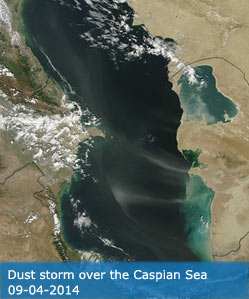Images
September 6, 2014 - Eruption at Bardarbunga, Iceland (Terra overpass, false color)
Tweet
Though photographers, seismologists, and automated webcams have been documenting the eruption near Iceland’s Bardarbunga volcano from the ground, satellite imagery has been scarce because of persistent cloud cover and a relatively small number of spacecraft that collect images at high latitudes. But in the past few days, NASA satellites have finally been able to observe the event from orbit.
At 12:45 p.m. Universal Time on August 31, 2014, the Moderate Resolution Imaging Spectroradiometer (MODIS) on NASA’s Aqua satellite acquired this false-color view of the eruption. This image uses a combination of infrared and visible light (MODIS bands 7-2-1) to highlight the heat signatures of the erupting lava and to distinguish glacial ice from clouds.
Swarms of earthquakes began near the volcano on August 16, and tremors have persisted in the weeks since (as many as 500 per day). To date, the Bardarbunga eruption has produced lava flows and fountains—some reaching 200 meters, or 650 feet—but no large ash plumes. As of September 3, the Icelandic Met Office reported that the new lava field spanned an area of 7.2 square kilometers (2.8 square miles), slightly larger than Gibraltar.
Scientists are watching closely to see how molten rock at and below the surface will interact with glacial ice, surface melt, and groundwater; their concern is for flooding on or near the Holuhraun lava field, or for steam explosions as water is superheated by the magma. Icelandic researchers also have surmised from GPS measurements of the deforming land surface that more magma is entering the dyke than is erupting on the surface.
Image Facts
Satellite:
Terra
Date Acquired: 8/31/2014
Resolutions:
1km ( B), 500m ( B), 250m ( B)
Bands Used: 7,2,1
Image Credit:
Jeff Schmaltz, MODIS Land Rapid Response Team, NASA GSFC
Tweet
Though photographers, seismologists, and automated webcams have been documenting the eruption near Iceland’s Bardarbunga volcano from the ground, satellite imagery has been scarce because of persistent cloud cover and a relatively small number of spacecraft that collect images at high latitudes. But in the past few days, NASA satellites have finally been able to observe the event from orbit.
At 12:45 p.m. Universal Time on August 31, 2014, the Moderate Resolution Imaging Spectroradiometer (MODIS) on NASA’s Aqua satellite acquired this false-color view of the eruption. This image uses a combination of infrared and visible light (MODIS bands 7-2-1) to highlight the heat signatures of the erupting lava and to distinguish glacial ice from clouds.
Swarms of earthquakes began near the volcano on August 16, and tremors have persisted in the weeks since (as many as 500 per day). To date, the Bardarbunga eruption has produced lava flows and fountains—some reaching 200 meters, or 650 feet—but no large ash plumes. As of September 3, the Icelandic Met Office reported that the new lava field spanned an area of 7.2 square kilometers (2.8 square miles), slightly larger than Gibraltar.
Scientists are watching closely to see how molten rock at and below the surface will interact with glacial ice, surface melt, and groundwater; their concern is for flooding on or near the Holuhraun lava field, or for steam explosions as water is superheated by the magma. Icelandic researchers also have surmised from GPS measurements of the deforming land surface that more magma is entering the dyke than is erupting on the surface.
Image Facts
Satellite:
Terra
Date Acquired: 8/31/2014
Resolutions:
1km ( B), 500m ( B), 250m ( B)
Bands Used: 7,2,1
Image Credit:
Jeff Schmaltz, MODIS Land Rapid Response Team, NASA GSFC




